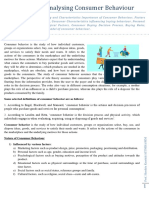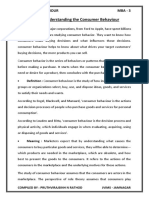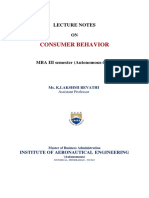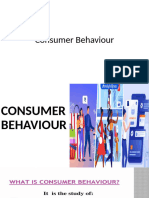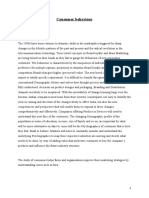MM Unit 2 Notes
MM Unit 2 Notes
Uploaded by
jratheshCopyright:
Available Formats
MM Unit 2 Notes
MM Unit 2 Notes
Uploaded by
jratheshOriginal Title
Copyright
Available Formats
Share this document
Did you find this document useful?
Is this content inappropriate?
Copyright:
Available Formats
MM Unit 2 Notes
MM Unit 2 Notes
Uploaded by
jratheshCopyright:
Available Formats
Modern Marketing
Unit – 2: Consumer Behaviour, Market Segmentation & Ethics in Marketing
CONSUMER BEHAVIORUR
Consumer behaviour indicates action of consumers with reference to activities that take place to satisfy their
needs.
According to American Marketing Association "consumer behaviour is need dynamic interaction of effect
and cognition, receive you and the environment by which human beings conduct exchange aspect of their
lives"
Factors influencing consumer behaviour
1. Internal factor
a. Perception: The process by which people understanding and translate information about world around
them. Perception will vary from person to person and different people perceive different things about the
same situation. Consumer perceive by seeing and hearing. Consumers perceive information about
products through advertisements, promotional campaigns, Offers, opinions of friends and relatives
reviews given by experts on television and feedback from existing users. Therefore consumer's
perception influences buying decisions and opinion about market.
b. Attitudes: Attitude refers to manner in which a person Carry's self. This includes way of Thinking or
feeling and action tendencies towards some object or idea. People generally expressed their attitude
almost towards everything whether it is clothes caste, culture, food, politics, brand etc. It is the attitude of
the people that creates a mindset to accept or reject.
For example in India people considered Chinese brands as inferior and American brands as superior this
attitude can hurt the marketing plans of Chinese brands, even if they offer quality products and services.
c. Motivation: Motivation is the willingness of someone to do something. an individual may have many
needs, summer biological needs such as air, food, drink and shelter. and other names are psychological
that are self-determination, Esteem, self actualization, love and affection. This will have a impact on
consumer behavior.
d. Learning: Learning is an activity of acquiring knowledge through observation, experience and practice
that may result in behavioral changes. A consumer learns about different products with this section
together the information during the Purchase process most of the learning is incidental and some of it are
intentional. Consumer learns about products through both direct and indirect experiences. Therefore,
Mr. Rathesh J, Asst Professor, St. Claret CollegePage 1
markets can use consumer learning as an instrument with the help of promotion and advertisement to
build a brand for a product or services.
e. Age groups: A person's age is another influential factor on purchasing behaviour of customers.
Purchasing habits fluctuate over the time with every generation and age group and keeping in mind
requirements of different age groups marketer have to execute different market Strategies for different
age groups.
f. Lifestyle: Lifestyle relates to the natural behaviour of human being. This includes pattern of living,
hobbies and opinions. Marketer should identify similarities in Lifestyle preferences of consumers and
develop products or services by aligning relationship between their products and lifestyle of consumers.
g. Income: Income is the monetary position of a person. Income earned by consumer has a direct impact on
the consumption pattern of the consumer, any changes in income will result in changes in quantity
purchased.
2. External influential factors
a. Culture: Culture refers to a set of beliefs, customs practices, norms and behaviour that exist with a
society. Cultural values and beliefs influence and changes the behaviour of consumer and it becomes
difficult for the marketers to predict this changes. Example family culture.
b. social class: Social class refers to the status ranking which individuals and groups with the society. Social
class is based on esteem and Prestige acquired through family background of education, occupation and
income. for example the working class, lower middle income class.
c. Reference group: Reference group is a set of people who form a standard. Reference groups identify and
set preferences for individuals in their purchase and consumption decisions, these groups when decide
what to wear and what brands to buy. For example student groups in colleges, neighborhoods, family,
work groups, shopping groups.
d. Gender roles: Gender role is another factor in consumer behaviour that plays a vital role in influencing
individual family decision making and ultimately the purchase of consumer goods.
e. Opinion leaders: Before making a purchase some of us take advice of certain person who has expertise
about the product. Opinion leaders refers to a person or organisation who influence people's behaviour
and attitude through their knowledge. An opinion leader can be a celebrity, politician, market leader,
religious leader, business community, journalist or an educator.
f. Physical environment: In most of the situation our modes and behaviours are strongly influenced by
physical surroundings. in this context a store environment can also influence. Physical store environment
is critical in buying behaviour of a consumer, because it directly affect consumers total shopping
experience.
Mr. Rathesh J, Asst Professor, St. Claret CollegePage 2
MARKET SEGMENTATION
According to William J Stanton “market segmentation in the process of dividing the total heterogeneous
market for good or service into several segments. Each of which tends to be homogeneous in all significant
aspects”.
Market segmentation creates a group of customers will be members within the group where similar likes,
tastes, needs, wants or preferences.
Objectives and significance of market segmentation
1. Customer satisfaction: satisfying the customer is the main aim of marketing and in order to satisfy the
customer satisfaction segmenting the whole market is very essential to objective. Segmented market helps
the marketer to increase the sales, by that customer can be targeted by marketer in only a segmented group
of customers.
2. Increased profit: By effective segmentation strategy marketing firm can actively respond to wants of
potential buyers through effective segments, this also allows marketing firm to increase sales which will
leads to higher profits.
3. Allocation of resources: With the help of segmenting the market, marketer can allocate the resources
effectively they can focus on a specific customer and retain customers. Selling more quantities of goods is
not only the aim of marketer. It also includes retaining the customers. It can be achieved through
segmenting a whole market into various segments. Intraday strategy of retaining one single customer in
different situations. For example a person goes through different phases from a school kid to a college
student.
4. Segment leadership: Strong market leadership is very essential to attain maximum profitability. Minor
marketing firm and new entity is suffers from low sales, however they can take a dominant share of
particular market segment carefully. Segmentation offers opportunity for smaller firms to compete with
bigger ones.
5. Marketing Communications: To acquire Marketing Information and communicate with the channels of
distribution is very essential to marketing firms to attain profitability.
Basis of segmentation
1. Demographic segmentation: Demographic segmentation divides market into segments taking into
consideration into demographic factors such as gender, age, social class, family life cycle, income,
occupation, education, religion, race, generation and nationality. Demographic segmentation strategy
Mr. Rathesh J, Asst Professor, St. Claret CollegePage 3
divides large population into specific customer groups with the objective to understand the prospective
customers segment and to take necessary action to increase sales and profitability. For example;
a) Fastrack is segmented the market on the basis of age and gender.
b) Audi is segmented the market on the basis of social class.
c) Sikkim Manipal University is segmented the market on the basis of education and trying to target
working professionals.
2. Behavioral segmentation: Behavioral segmentation based on product consumption, related to behavior it
includes Expectations, usage of product, price sensitivity, occasion of use and attitude. A same product
can be used for different purpose, or different occasions and in different quantities.
3. Psychographic segmentation: Marketer needs to understand requirements of customer psychology, along
with needs. Psychographic segmentation is a method of dividing markets on the basis of the psychology
and Lifestyle habits, interests, activities and opinions of customers.
4. Cross-culture segmentation: Globalization leads to worldwide Marketplace. This means marketing is now
becoming if world common discipline. Thus marketers can opt for cross culture segmentation. Teenagers
across the globe offering similar product of different countries and marketer is using the same culture of
other countries where they are trying to promote their products.
5. Geographic segmentation: Geographical segmentation divides the market according to geographical unit
such as Nation, States, regions, cities or natural boundaries. Another dimension of Geographic
segmentation is that people who live in the same area usually share similar needs and wants for example
people who lives in North India prefer tea and in South India people prefer coffee.
6. Socio-economic segmentation: In socio-economic segmentation the marketer divides the entire market
into segments according to their income and social class. This is also a part of demographic segmentation.
Ethics in Marketing
Marketing ethics refers to the moral principles and standards that guide behavior in the world of marketing.
It involves applying honesty, fairness, and responsibility to advertising, sales, distribution, and other
marketing activities to ensure that businesses conduct their operations in a way that is both ethical and
consumer-friendly.
Meaning of Ethics in Marketing
Ethics in marketing pertains to the moral code of conduct that businesses are expected to follow when
promoting and selling their products or services. It includes ensuring truthful advertising, respect for customer
privacy, and adherence to laws and regulations governing marketing practices. It aims to avoid misleading
claims, exploitation, and unethical competitive behavior.
Mr. Rathesh J, Asst Professor, St. Claret CollegePage 4
Key Components of Marketing Ethics:
o Honesty and transparency in advertising and communication.
o Fair pricing and product information.
o Respect for consumer privacy and data protection.
o Avoiding exploitation or manipulation of vulnerable groups (e.g., children, elderly).
o Ethical treatment of competition and stakeholders.
Importance of Ethics in Marketing
Marketing ethics is critical for building trust, credibility, and loyalty with consumers. It has become an
essential aspect of business success, especially in an era of informed and socially-conscious consumers.
Builds consumer trust: Ethical marketing enhances brand reputation and fosters trust, leading to
long-term customer loyalty.
Protects against legal issues: Following ethical practices ensures compliance with laws and
regulations, preventing lawsuits, fines, or penalties.
Boosts competitive advantage: Companies that are perceived as ethical often enjoy a competitive
edge, as many consumers prefer buying from responsible brands.
Improves corporate reputation: Ethical marketing contributes to a positive image, helping
businesses stand out in a crowded marketplace.
Ensures social responsibility: Ethical companies contribute positively to society by engaging in
socially responsible marketing activities.
Role of Ethics in Marketing
Ethical considerations in marketing play a vital role in ensuring that businesses operate with integrity and
fairness toward consumers, competitors, and the general public.
1. Honest Communication: Ensuring that advertising, branding, and promotional messages reflect the
truth. Misleading claims, false advertising, and deceptive marketing practices are unethical.
Mr. Rathesh J, Asst Professor, St. Claret CollegePage 5
2. Fair Pricing: Setting prices that are fair, avoiding price gouging or discrimination, and ensuring
transparency in pricing strategies.
3. Respecting Consumer Privacy: Safeguarding consumer data and using it responsibly, especially in
the digital age. Ethical marketing ensures that data collection, usage, and sharing are done with
consumers’ consent.
4. Responsibility to Society: Marketing campaigns should promote products or services in a way that
benefits society. Avoid promoting harmful products, encouraging wasteful consumption, or targeting
vulnerable groups like children or those in financial distress.
5. Ethical Competition: Ensuring fair competition by respecting competitors and avoiding unfair
practices such as defamation, price-fixing, or poaching customers through unethical means.
Marketing Ethics in the Digital Age
The digital era has introduced new challenges for marketing ethics, especially with the rise of data-driven
marketing, social media, and targeted advertising. In the online world, consumer data and privacy are at the
forefront of ethical marketing concerns.
Data Privacy: The collection, use, and sharing of personal data is one of the most pressing ethical
issues in digital marketing. Ethical marketing ensures transparency in how data is gathered (e.g.,
cookies, browsing history), stored, and used for marketing purposes.
o General Data Protection Regulation (GDPR): Laws like GDPR ensure that businesses handle
customer data responsibly, giving users control over their data.
Truthfulness in Online Advertising: Digital platforms allow for personalized and targeted
advertisements. Marketers must ensure that online ads are not misleading, deceptive, or intrusive.
False reviews, hidden advertisements (native ads), and clickbait tactics are unethical.
Influencer Marketing and Transparency: Influencer marketing has grown substantially in the
digital age. Ethical practices demand transparency, such as influencers disclosing paid partnerships or
sponsorships.
Artificial Intelligence (AI) and Automation: AI-driven marketing tools, like chatbots and
personalized ads, must be deployed ethically. Over-automation that deceives consumers into thinking
they are interacting with real people or AI tools collecting excessive personal data raises ethical
concerns.
Mr. Rathesh J, Asst Professor, St. Claret CollegePage 6
Social Media Ethics: Social media platforms have become powerful tools for marketers. However,
ethical challenges arise when platforms are used to spread misinformation, manipulate consumers, or
promote harmful content. Marketers should ensure that they contribute positively to online discourse
and do not exploit user vulnerabilities.
Key Ethical Issues in Digital Marketing:
Targeted Advertising: While targeted ads can be effective, ethical concerns arise when they
manipulate consumer behavior, especially when based on sensitive information (e.g., health or
financial data).
Clickbait: Sensationalized headlines or deceptive ads designed to generate clicks often mislead
consumers and can damage trust.
Fake Reviews and Testimonials: In the digital age, some businesses manipulate customer reviews to
boost their products, which is unethical and can mislead potential buyers.
Cybersecurity: Companies must take responsibility for securing customer data from breaches and
cyberattacks. Ethical businesses invest in strong data protection measures.
Ethical Marketing Practices in the Digital Age
1. Transparency: Being clear and upfront about data usage, pricing, product claims, and partnerships is
crucial. Customers should know what data is being collected and how it is being used.
2. Consent: Ethical marketing ensures that consumers have the ability to opt-in or opt-out of data
collection practices, email campaigns, and other marketing activities.
3. Respect for Consumer Autonomy: Avoiding manipulative techniques like dark patterns (designs that
trick users into taking actions they didn’t intend) ensures that consumers are in control of their
decisions.
4. Corporate Social Responsibility (CSR): Engaging in responsible digital marketing practices, such as
supporting environmental sustainability or promoting positive societal changes through digital
campaigns.
Mr. Rathesh J, Asst Professor, St. Claret CollegePage 7
You might also like
- SAMPLE MCQuestions ByTopicsDocument45 pagesSAMPLE MCQuestions ByTopicsVeeru ManikantaNo ratings yet
- Solution Manual Consumer Behavior Buying Having and Being 12th Global Edition E Michael R Solomon Complete Downloadable File atDocument21 pagesSolution Manual Consumer Behavior Buying Having and Being 12th Global Edition E Michael R Solomon Complete Downloadable File atNouran Baker0% (1)
- 2001 - Boud - Journal Writing To Enhance Reflective PracticeDocument7 pages2001 - Boud - Journal Writing To Enhance Reflective Practiceophelia elisa novitaNo ratings yet
- Consumer BehaviourDocument10 pagesConsumer BehaviourSara ZafarNo ratings yet
- Consumer Behavior Unit 1Document53 pagesConsumer Behavior Unit 1avnidtuNo ratings yet
- Cpnsumer Behaviour PDFDocument7 pagesCpnsumer Behaviour PDFVIDHI KAMATH 2122084No ratings yet
- Module 2Document29 pagesModule 2Rabindra DashNo ratings yet
- Consumer Behavior:: It Is A Set of Processes A Consumer Uses To Make Purchase Decisions, AsDocument9 pagesConsumer Behavior:: It Is A Set of Processes A Consumer Uses To Make Purchase Decisions, AsVikas ChaudharyNo ratings yet
- Consumer Behaviour AssignmentDocument4 pagesConsumer Behaviour AssignmentDhiraj PandeyNo ratings yet
- Module 2 - Analysing Consumer BehaviourDocument16 pagesModule 2 - Analysing Consumer BehaviourDigit GoNo ratings yet
- Unit 3Document28 pagesUnit 3PRABHAKAR RAONo ratings yet
- Sikkim Manipal MBA, MK0010 Third Semester MK00101Document24 pagesSikkim Manipal MBA, MK0010 Third Semester MK00101Manoj KumarNo ratings yet
- Unit 1 - RMDocument32 pagesUnit 1 - RMDr Rakesh ThakorNo ratings yet
- Unit 1Document9 pagesUnit 1Himanshu DarganNo ratings yet
- Hero MotocorpDocument64 pagesHero MotocorpAnkit Kumar100% (2)
- DissertatioC BDocument16 pagesDissertatioC BKumar SwamyNo ratings yet
- Chapter 4 SegementationDocument7 pagesChapter 4 SegementationJk KNo ratings yet
- TH ReviewerDocument8 pagesTH ReviewerLenard vilanuevaNo ratings yet
- ParaphraseDocument14 pagesParaphraseHannah ArohaNo ratings yet
- Unit 1 QBADocument9 pagesUnit 1 QBADr Rakesh ThakorNo ratings yet
- CB AssignmentDocument17 pagesCB AssignmentKuldeep TomarNo ratings yet
- Factors Influencing Consumer Buying Behavior in The Life Insurance Industry A Comparative Analysis ofDocument40 pagesFactors Influencing Consumer Buying Behavior in The Life Insurance Industry A Comparative Analysis ofwaghdharesarthak41No ratings yet
- A Study On Customer Satisfaction Towards ADIDASDocument77 pagesA Study On Customer Satisfaction Towards ADIDASGopi Chandu.keerthi75% (4)
- Marketing ManagementDocument52 pagesMarketing Managementsaloni yadavNo ratings yet
- Unit 1: Understanding The Consumer BehaviourDocument28 pagesUnit 1: Understanding The Consumer Behaviourpruthvirajsinh rathoreNo ratings yet
- Study Material - Consumer BehaviourDocument19 pagesStudy Material - Consumer BehaviourSUBHRAJYOTINo ratings yet
- Unit 1Document27 pagesUnit 1LOOPY GAMINGNo ratings yet
- Consumer BehaviourDocument20 pagesConsumer BehaviourVidya shree BGNo ratings yet
- Module 2Document10 pagesModule 2kidiv39831No ratings yet
- Consumer Behaviour - Introduction - Chapter 1Document16 pagesConsumer Behaviour - Introduction - Chapter 1Syed Muheeb HussainNo ratings yet
- CBMR Unit 1Document50 pagesCBMR Unit 1A SoundariyaNo ratings yet
- Chap 2 - Consumer Behavior and Market SegmentationDocument17 pagesChap 2 - Consumer Behavior and Market Segmentationbegumayesha7366No ratings yet
- CB NotesDocument28 pagesCB NotesSakshi RathodNo ratings yet
- Mid Term Exam Marketing Planning and Strategy_Raissa Adelia Nurzaman_120310213005Document6 pagesMid Term Exam Marketing Planning and Strategy_Raissa Adelia Nurzaman_120310213005Raissa AdeliaNo ratings yet
- Sbaa 7009Document96 pagesSbaa 7009Dr. Hamza. V KNo ratings yet
- Tvs Final ProjectDocument56 pagesTvs Final ProjectSaurabh KumarNo ratings yet
- PM Chapter 3 &4Document21 pagesPM Chapter 3 &4የገጠር ልጅNo ratings yet
- Module 3Document5 pagesModule 3Anand HIREMATHNo ratings yet
- Factors Influencing Consumer Behavior - College HiveDocument3 pagesFactors Influencing Consumer Behavior - College HiveS Ms.No ratings yet
- Unit 1 &2 MarketingDocument13 pagesUnit 1 &2 Marketingsankalp mohantyNo ratings yet
- MARKETING UNIT-2Document12 pagesMARKETING UNIT-2junejajoy142No ratings yet
- IARE - CB - Lecture - Notes-1-10Document10 pagesIARE - CB - Lecture - Notes-1-10Santhosh Kumar MaduraiNo ratings yet
- Consumer Behaviour NotesDocument59 pagesConsumer Behaviour NotesJosh GraciousNo ratings yet
- CB ReportDocument26 pagesCB ReportNandini BhattacharjeeNo ratings yet
- 21PMBSE033 OVERSEAS BUYING BEHAVIOUR UNIT 1 NotesDocument22 pages21PMBSE033 OVERSEAS BUYING BEHAVIOUR UNIT 1 Notesjawaharkumar MBANo ratings yet
- MM-Module 2Document10 pagesMM-Module 2Badiger DiwakarNo ratings yet
- MODULE 2-1Document22 pagesMODULE 2-1Manjula SajeevNo ratings yet
- Consumer Behavior NotesDocument12 pagesConsumer Behavior NotesÇhand Mal AgarwalNo ratings yet
- Unit 1 & 2 CBDocument21 pagesUnit 1 & 2 CBVilakshNo ratings yet
- Profile The Market NewDocument10 pagesProfile The Market Newdenekedarchu358No ratings yet
- Module 1 - Consumer BehaviourDocument17 pagesModule 1 - Consumer BehaviourPrashansa SumanNo ratings yet
- Consumer BehaviourDocument4 pagesConsumer BehaviourAmit GargNo ratings yet
- CB NotesDocument32 pagesCB NotesArun P PrasadNo ratings yet
- Consumer BehaviorDocument74 pagesConsumer BehaviorV.S.KUMAR SISHTANo ratings yet
- Chapter 1 (Consumer Behaviour)Document84 pagesChapter 1 (Consumer Behaviour)ashinashinesNo ratings yet
- Unit II MMDocument8 pagesUnit II MMJatinsinghNo ratings yet
- Vipn ProjectDocument68 pagesVipn Projectvishu131No ratings yet
- CB Unit 1 MB202 (M2)Document14 pagesCB Unit 1 MB202 (M2)AnkitNo ratings yet
- IM1019 L5 Consumer Markets and Buyer BehaviorDocument51 pagesIM1019 L5 Consumer Markets and Buyer BehaviorDƯƠNG NGUYỄN THÁI BÌNHNo ratings yet
- ChatGPT and Neuromarketing Mastery - Using AI to Tap into the Psychology of BuyingFrom EverandChatGPT and Neuromarketing Mastery - Using AI to Tap into the Psychology of BuyingNo ratings yet
- How to Learn Digital Marketing from Scratch and Alone - Volume 06: Marketing Psychology: Understanding Consumer BehaviorFrom EverandHow to Learn Digital Marketing from Scratch and Alone - Volume 06: Marketing Psychology: Understanding Consumer BehaviorNo ratings yet
- The Acquisition of Phonological InventoriesDocument28 pagesThe Acquisition of Phonological InventoriesBunmi Bdaejo Bunmi BadejoNo ratings yet
- Ingold - Part 2 - 5Document12 pagesIngold - Part 2 - 5Althea Mola CruzNo ratings yet
- An Exploratory Study of Sensory GardensDocument8 pagesAn Exploratory Study of Sensory Gardenscalderdavid35No ratings yet
- KM07 - Faerie MysteriesDocument29 pagesKM07 - Faerie MysteriesYokius Crow100% (2)
- Creative Industries Final September 2016 PDFDocument33 pagesCreative Industries Final September 2016 PDFSankalp ZoreNo ratings yet
- The Antimicrobial Resistance Crisis: Causes, Consequences, and ManagementDocument8 pagesThe Antimicrobial Resistance Crisis: Causes, Consequences, and ManagementPichayaNo ratings yet
- Strategic Service Management PDFDocument14 pagesStrategic Service Management PDFMarwaneEl-lamraniNo ratings yet
- Chris Crawford - The Art of Computer Game DesignDocument96 pagesChris Crawford - The Art of Computer Game Designdiderot100% (21)
- Information ProcessingDocument6 pagesInformation ProcessingCarl LibatiqueNo ratings yet
- Q2 - Diss - Week 1 & 2Document17 pagesQ2 - Diss - Week 1 & 2Godofredo HermosuraNo ratings yet
- Deity Worship-Jaiva DharmaDocument6 pagesDeity Worship-Jaiva DharmaMurtiman Madhav das100% (1)
- How To Evaluate Six Neurocognitive Domains For Dementia Subtypes?Document27 pagesHow To Evaluate Six Neurocognitive Domains For Dementia Subtypes?johnny chaw100% (1)
- Modular Instruction Manual FOR English 5 (Reading Remediation) S.Y.:2021-2022Document18 pagesModular Instruction Manual FOR English 5 (Reading Remediation) S.Y.:2021-2022Pandaog Al-hadzrieNo ratings yet
- Hooper-Greenhill E Museums and Education Purpose PDocument6 pagesHooper-Greenhill E Museums and Education Purpose PClaudia Alfaro MoisaNo ratings yet
- Auditory, Visual, and Physical Distractions in The WorkplaceDocument11 pagesAuditory, Visual, and Physical Distractions in The Workplaceai212983100% (4)
- Variable Kith ConstructionDocument17 pagesVariable Kith ConstructionGnomeMadeIon100% (1)
- Manly P Hall - PARACELSUSDocument82 pagesManly P Hall - PARACELSUSmaggie144100% (24)
- SoulmakingDocument8 pagesSoulmakingMIAO, RONAMIE E.No ratings yet
- Download Complete Defensive Living Preserving Your Personal Safety Through Awareness Attitude and Armed Action 2nd Edition Ed Lovette PDF for All ChaptersDocument82 pagesDownload Complete Defensive Living Preserving Your Personal Safety Through Awareness Attitude and Armed Action 2nd Edition Ed Lovette PDF for All Chaptersaniinayasuta55100% (3)
- 2019 Understanding Emotional Thought Can Transform Educators' Understanding of How Students Learn PDFDocument26 pages2019 Understanding Emotional Thought Can Transform Educators' Understanding of How Students Learn PDFFatima SerraoNo ratings yet
- Jai MiniDocument63 pagesJai MiniJaimini PrajapatiNo ratings yet
- Digital ShockDocument41 pagesDigital ShockAmanda AhopeltoNo ratings yet
- Sensory Study in Restaurant Interior DesignDocument80 pagesSensory Study in Restaurant Interior DesignAjay Walia100% (1)
- Lacanian Approach To Problems of Affect and Anxiety in Psychoanalysis PDFDocument30 pagesLacanian Approach To Problems of Affect and Anxiety in Psychoanalysis PDFAngel HsiehNo ratings yet
- Philosophy Worksheet FinalDocument8 pagesPhilosophy Worksheet FinalRowena Chua AlvarezNo ratings yet
- Perception Perception Refers To The Interpretation of TheDocument5 pagesPerception Perception Refers To The Interpretation of ThecatkatiyarNo ratings yet
- A Neuroscientist Reveals How To Think DifferentlyDocument2 pagesA Neuroscientist Reveals How To Think DifferentlychandraNo ratings yet
- Workshop Simondon and Digital Culture PDFDocument7 pagesWorkshop Simondon and Digital Culture PDFPerched AboveNo ratings yet









